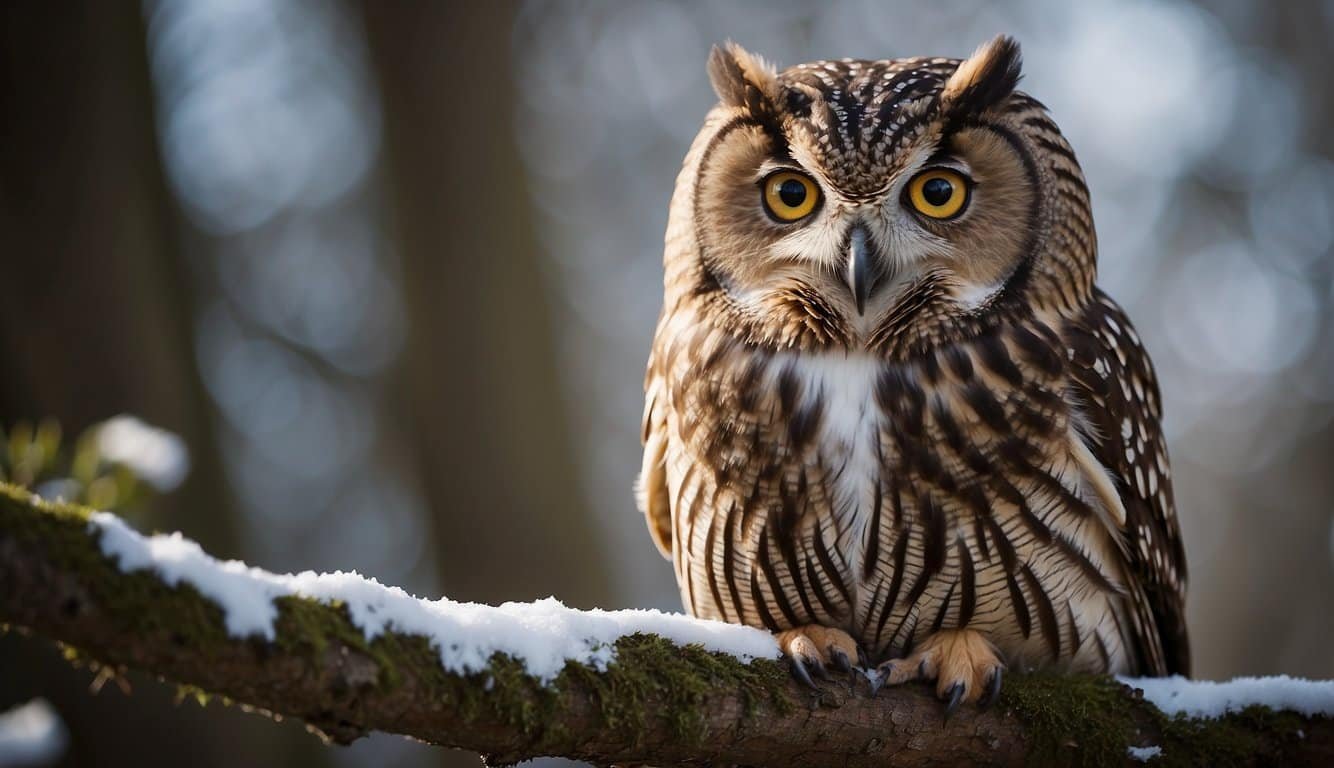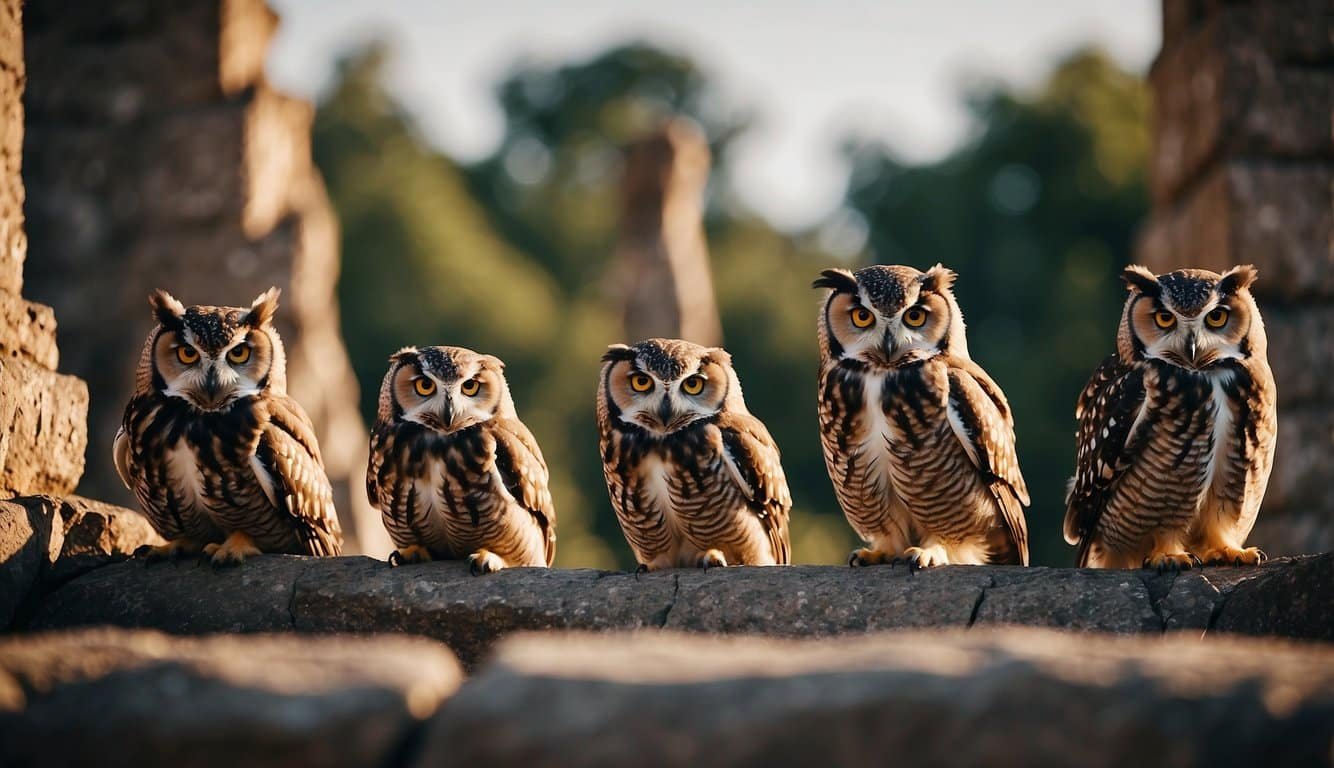Owl Basics

Owls are fascinating birds, holding a special place in various cultures, often associated with wisdom and the mystical. They belong to the order Strigiformes, which includes around 200 species divided into two families: Strigidae, or true owls, and Tytonidae, consisting of barn owls.
True owls, such as the great horned owl and the snowy owl, have varied sizes and plumage, adapted to environments ranging from forest to tundra. Barn owls, recognizable by their heart-shaped faces, are experts in rodent control and can be found in regions including Europe, Africa, and the Americas. The owl’s feathers, crucial for silent flight, allow them to sneak up on prey undetected.
What distinguishes owls from other birds are their forward-facing eyes and excellent night vision, making them formidable nocturnal hunters. Their eyes are supported by a boney structure in the skull, giving them a binocular vision effect and depth perception necessary for hunting in darkness. Additionally, their beak and talons are strong and sharp, perfect for catching and devouring prey.
Despite being predominately nocturnal, some owls, like the northern hawk-owl and the northern pygmy-owl, are diurnal and active during the day. When it comes to their calls, owls are known for their hoots, which can range in sound depending on the species; the owl uses these calls to communicate with other owls and establish territory.
From the elf owl, the smallest at just 5 inches tall, to the imposing great gray owl, which can have a wingspan of up to 5 feet, owls are diverse and intriguing members of the bird family well-adapted to their various habitats. Whether swooping down with almost inaudible flight or rotating their heads to incredible angles, owls continue to capture our curiosity and admiration.
Hunting and Diet
Owls are enigmatic birds of prey known for their incredible hunting skills and varied diet. They are masters of the silent hunt, thriving in diverse habitats around the globe.
Predatory Skills
With silent flight, thanks to their specialized feathers, owls are adept hunters that can sneak up on their prey—often rodents or other small mammals—unnoticed. Their forward-facing eyes allow for precise depth perception, while their acute hearing aids them in pinpointing the exact location of their prey, even under snow or foliage.
Meal and Nutrition
An owl’s diet typically consists of a carnivorous menu, including a variety of small mammals, birds, and even fish. Specific species, like the Fish Owl, have adapted to hunt primarily aquatic prey. Owls swallow their prey whole when possible and later regurgitate indigestible parts like bones and fur in the form of pellets.
Habitat and Distribution
From the snowy expanses of the tundra where the Snowy Owl reigns supreme to the dense woodlands preferred by the Barred Owl, these raptors are found on every continent except Antarctica. Their habitats range from deserts to grasslands, highlighting their adaptability.
Reproduction and Life Cycle
During the breeding season, male and female owls engage in a series of courtship behaviors, from duetting hoots to aerial displays. After mating, they will nest and raise their young. Owls like the Northern Saw-whet Owl are known for their secrecy during this critical period.
Conservation Status
Many owl species face threats from habitat loss and environmental changes. The barn owl and others are part of conservation efforts to mitigate the dangers they encounter, ranging from the decrease in prey availability to human-made hazards.
Communication and Social Behavior
Owls communicate through a variety of vocalizations and behaviors, from the iconic hoot to body language that conveys everything from mating readiness to warning off potential predators. The Northern Hawk Owl, for instance, has distinct calls for different situations, echoing through its habitat.
Cultural Significance and Human Relations

Throughout history, owls have been figures of intrigue and mystery in various cultures, often steeped in symbolism and myth. In Greek mythology, the owl is a sacred creature associated with Athena, the goddess of wisdom, where it symbolizes knowledge and is revered as a symbol of guidance. This association has left a lasting impression on the cultural fabric of many societies where owls still represent intelligence and foresight.
Contrastingly, in some cultures, owls are linked with less positive connotations, such as harbingers of death or bad omens, connected to their silent flight and nocturnal habits. These birds have sparked a unique blend of fear and fascination that heavily influences folklore and superstitious beliefs, emphasizing the dichotomy of human emotions towards these raptors.
The anthropomorphism of owls in media and literature has further shaped their role in human culture, often portraying them as wise and noble creatures. These representations foster a connection between owls and human traits, encouraging conservation efforts and raising awareness of their ecological importance.
Educational initiatives utilize the allure of owls to teach about nature and the need for habitat preservation. By highlighting the role of owls as indicators of environmental health and as controllers of rodent populations, awareness programs advocate for their protection and the broader implications of maintaining biodiversity.
In summary, owls are emblematic of a complex relationship between humans and nature, with their cultural significance reflecting the diverse perspectives and values that people attribute to the natural world.
See owls in Greek civilization and their symbolism, the human-strigiform interfaces, and the insight into cultural perceptions of animal metaphors for further reading on these feathered enigmas.

